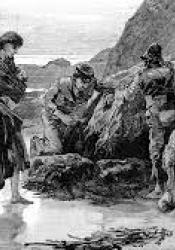The Great Famine
The Great Famine was a time of turmoil in the United Kingdom that led to millions of deaths. Before examining the implications that arose during the Great Hunger (1845-49) for Britain, it is first important to understand that at this time Ireland was part of the United Kingdom. Like England, the Irish population increased exponentially in the first half of the nineteenth century, reaching a population of nearly nine million people by 1845. With this population growth, class divisions became prominent, unfortunately creating more people in the peasant class. Peasants heavily relied on farming potatoes in Ireland as they were not only plentiful but could also be sold as food to provide income to many families in poverty. Because of this, the peasants were expected to grow the largest crop possible, which began with planting the Aran Banner variety of potato. Unfortunately, this variety was the most susceptible to a fungus that had come from North America called Phytophthora Infestans, more commonly known as Blight. Once this disease hit the farms in Ireland, it advanced throughout the land with lethal quickness. Eventually, the entire year’s crop was lost. This was extremely unexpected for the United Kingdom, which made matters worse as there was no backup solution to feed the inhabitants of Ireland.
Following the evaporation of the food supply in Ireland, the three kingdoms underwent extreme distress. By January of 1846, the British Parliament, under the direction of prime minister Sir Robert Peel, purchased one hundred thousand pounds worth of foreign corn in attempt to replace the supply of potatoes with corn. However, this did little to help the Irish population. Moreover, the corn was so hard and had such awful quality that the Irish began calling it “Peel’s brimstone.” To provide employment, the government began road and canal building; however, many workers died by the end of the week before receiving their payments. The loss of crops left many peasants without work. Between 1815-1846, the government placed tariffs on corn, wheat, barley, and all other grains which caused the price of these items to rise significantly. In 1846, these tariffs were finally appealed, but this did little to help the lower-class citizens as they had no money. No matter how cheap the food was, no one could afford it.
Irish tradition presented the idea that following a bad year for crops, the next year would be abundant and make up for the loss. This seemed to be true by May and June of 1846, with the farms supplying plentiful amounts of potatoes. “Father Mathew, the famous Temperance reformer, travelling from Cork to Dublin on July 27th, saw the ‘plant blooming in all the luxuriance of an abundant harvest.’ Five days later he travelled back to find ‘one wide waste of putrefying vegetation.’ At the edge of their decaying patches the people sat weeping and wringing their hands” (Victorianweb.org, 1). The struggles of the Irish continued, and by this point the despair became worse than ever following the false sense of hope. Moreover, prime minister Peel was replaced by Lord John Russell who passionately believed in laissez-faire, on this matter Professor Brantlinger writes “If in the crisis of the Famine, laissez-faire economics, combined with Malthusian population theory, helped not at all, evangelical providentialism, especially when spiced by anti-Catholicism, also helped not at all” (Brantlinger, 198). Furthermore, Russell believed that the wealth of Ireland should be responsible for Ireland; therefore, Russell did nothing to assist the Irish in their struggles with the famine. Finally, “In January 1847 Russell's administration modified its non-interventionist policy and made money available on loan for relief, and soup kitchens were established. The potato crop did not fail in 1847, but the yield was low. Then, as hundreds of thousands of starving people poured into the towns and cities for relief, epidemics of typhoid fever, cholera, and dysentery broke out, and claimed more lives than starvation itself” (Bloy, 4). Overall, roughly six and a half million people died due to the Great Famine, and many emigrated to other parts of the world.
The Irish Potato Famine caused many changes in the United Kingdom, but the most important correlations between the famine and literature are harder to evaluate. Among these, however, may be the division that was created between the English/Scottish and Irish, and the themes of nationalism that began developing in Ireland following the famine. In fact, Irish nationalists believed, in the nineteenth century, that the lack of help from England was a “a deliberate murder or extermination - what we would now call genocide” (Brantlinger, 194). Moreover, poetry was heavily impacted, and some consider 1845-1850 to be its own period of literature known as “Famine Poetry.” However, the lack of literature from this period may speak louder than any piece of literature can. The famine brought great economic, literary, and political change for the United Kingdom, and changed the course of unity in the U.K. forever.
Works Cited
Bloy, Marjie. “The Irish Famine: 1845-9.” The Irish Famine, 2022, https://victorianweb.org/history/famine.html.
Victorianweb.org. The Potato Famine in Ireland, https://victorianweb.org/history/lucanireland.html.
Brantlinger, P. (2004). The Famine. JSTOR. Retrieved November 3, 2022, from https://www.jstor.org/

